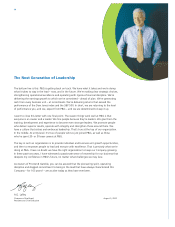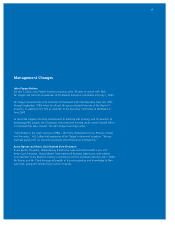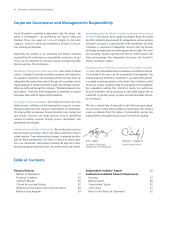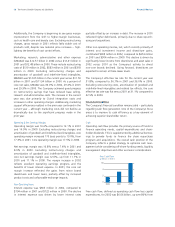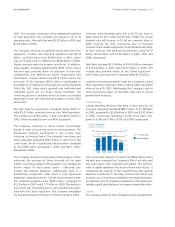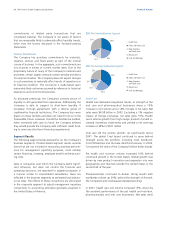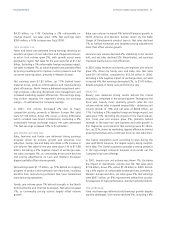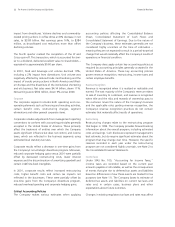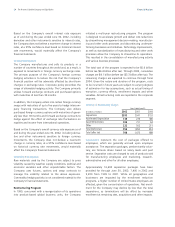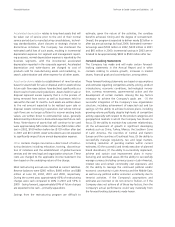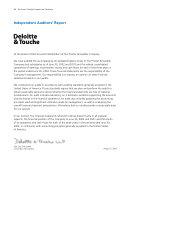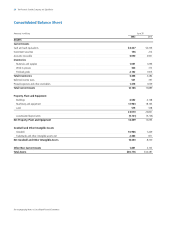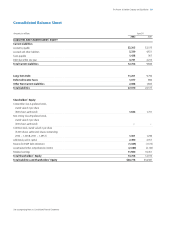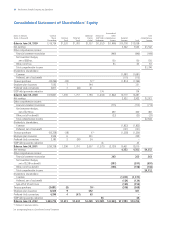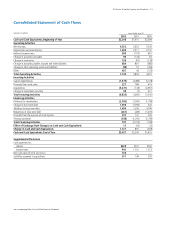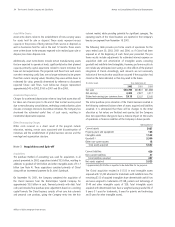Proctor and Gamble 2002 Annual Report Download - page 26
Download and view the complete annual report
Please find page 26 of the 2002 Proctor and Gamble annual report below. You can navigate through the pages in the report by either clicking on the pages listed below, or by using the keyword search tool below to find specific information within the annual report.
Financial Review24 The Procter & Gamble Company and Subsidiaries
Based on the Company’s overall interest rate exposure
as of and during the year ended June 30, 2002, including
derivative and other instruments sensitive to interest rates,
the Company does not believe a near-term change in interest
rates, at a 95% confidence level based on historical interest
rate movements, would materially affect the Company’s
financial statements.
Currency Rate Exposure
The Company manufactures and sells its products in a
number of countries throughout the world and, as a result, is
exposed to movements in foreign currency exchange rates.
The primary purpose of the Company’s foreign currency
hedging activities is to reduce the risk that the Company’s
financial position will be adversely affected by short-term
changes in exchange rates. Corporate policy prescribes the
range of allowable hedging activity. The Company primarily
utilizes forward exchange contracts and purchased options
with maturities of less than 18 months.
In addition, the Company enters into certain foreign currency
swaps with maturities of up to five years to hedge intercom-
pany financing transactions. The Company also utilizes
purchased foreign currency options with maturities of gener-
ally less than 18 months and forward exchange contracts to
hedge against the effect of exchange rate fluctuations on
royalties and income from international operations.
Based on the Company’s overall currency rate exposure as of
and during the year ended June 30, 2002, including deriva-
tive and other instruments sensitive to foreign currency
movements, the Company does not believe a near-term
change in currency rates, at a 95% confidence level based
on historical currency rate movements, would materially
affect the Company’s financial statements.
Commodity Price Exposure
Raw materials used by the Company are subject to price
volatility caused by weather, supply conditions, political and
economic variables and other unpredictable factors. The
Company uses futures, options and swap contracts to
manage the volatility related to the above exposures.
Commodity hedging activity is not considered material to the
Company’s financial statements.
Restructuring Program
In 1999, concurrent with a reorganization of its operations
into product-based global business units, the Company
initiated a multi-year restructuring program. The program
is designed to accelerate growth and deliver cost reductions
by streamlining management decision-making, manufactur-
ing and other work processes and discontinuing under-per-
forming businesses and initiatives. Technology improvements,
as well as standardization of manufacturing and other work
processes allow the Company to streamline its operations.
This resulted in the consolidation of manufacturing activity
and various business processes.
The total cost of the program is expected to be $5.6 billion
before tax ($4.4 billion after tax). Through 2002, cumulative
charges are $4.1 billion before tax ($3.3 billion after tax). The
remaining charges are expected to continue through fiscal
2004. Given the nature and duration of the program, costs
to be incurred in future years are subject to varying degrees
of estimation for key assumptions, such as actual timing of
execution, currency effects, enrollment impacts and other
variables. All restructuring costs are reported in the corporate
segment.
Separations represent the cost of packages offered to
employees, which are generally accrued upon employee
acceptance. The separation packages, predominantly volun-
tary, are formula driven based on salary levels and past
service. Separation costs are charged to cost of products sold
for manufacturing employees and marketing, research,
administrative and other for all other employees.
Approximately 16,600 separation packages have been
provided for through June 30, 2002: 7,400 in 2002 and
9,200 from 1999 to 2001. While all geographies and
businesses are impacted by the enrollment reduction
programs, a higher number of United States employees are
affected, given the concentration of operations. Net enroll-
ment for the Company may decline by less than the total
separations, as terminations will be offset by increased
enrollment at remaining sites, acquisitions and other impacts.
Summary of Restructuring Charges
(in millions of dollars)
Separations
Accelerated Depreciation
Asset Write-Downs
Other
Total (before tax)
Total (after tax)
$153
386
64
211
814
688
$341
276
731
502
1,850
1,475
$393
135
208
222
958
706
Years Ended June 30
2002 2001 2000


